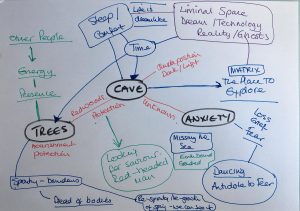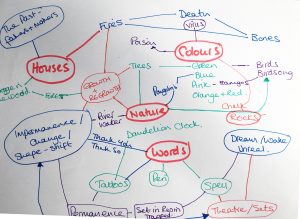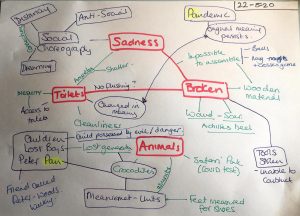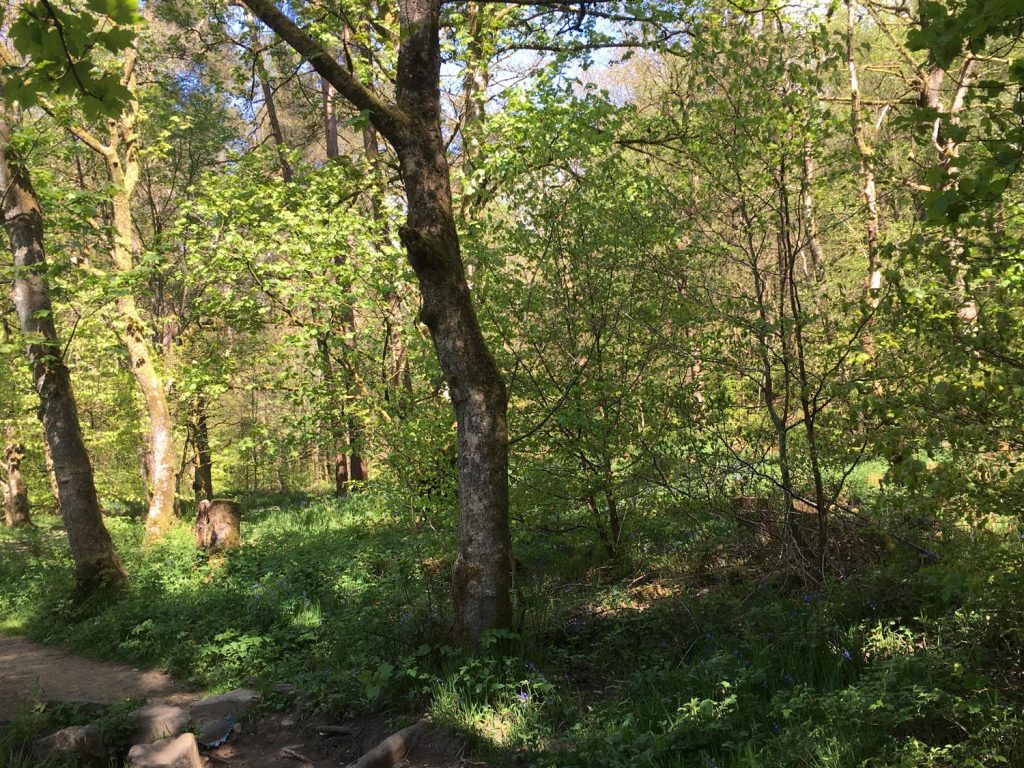This is the second chapter of my odyssey in Social Dreaming, as a potential process for recruiting many voices, stories and creative flows towards creating a different kind of art.
In February and March 2020, I hosted three sessions in association with Slung Low in Leeds to start a journey of exploration, to discover whether, and how, Social Dreaming might work in a circular way as both a generative and reflective/ evaluative process in the creative cycle. Using the structure of The Social Dreaming Matrix, a gathering of people shared dreams, associations, images and memories in a cosy space on the upper deck of the Community Cultural College bus in Holbeck. We then spent time mapping the most prominent, memorable or otherwise significant themes and images to emerge
Almost immediately after the third session, the country started to close down in response to COVID-19. The social element of Social Dreaming was no more. The experiment had been brought to a close.
Or had it?
I went back to the origins of Social Dreaming : the collection, by psychotherapist Charlotte Beradt in 1930’s Germany, of dreams of her and colleagues’ clients; how looking back across the collection years later, it pre-figured the horrors of the Third Reich to come, and the impact of thought control by a brutal authoritarian regime. She wrote of this in her book The Third Reich of Dreams.
I traced how Social Dreaming, through the work of social scientist Gordon Lawrence at the Tavistock Clinic in the 1980’s, was developed as a way to understand the collective and connected unconscious, not just as individual analysis; how within the framing of a ‘Matrix’ where dreams are shared, it could shine insight into a community, a society, the human condition.
I consulted with colleagues who have extensive experience and knowledge of Social Dreaming, and we agreed that many of the conditions of The Matrix could be created through virtual means. This would be a further stage in the evolution of Social Dreaming as a psycho-social technique developed over the past 30 years, and in the exploration of it as a creative tool. The Art of Social Dreaming was already a journey of discovery, and now we were being forced to abandon the original map of physical coming-together, and set off into unknown terrain, the virtual world.
I contacted the original attendees from the Holbeck events and also reached out via social media, including to the Social Dreaming Community Facebook group. The invitation was to an event of 150 minutes, with an introduction, an hour’s Matrix and a post-matrix discussion. The online format had the benefits of potentially involving people from much further afield, and also being able to share the creative stimuli the night before, so that participants’ dreams could potentially respond to them.
The first Art of Virtual Social Dreaming event took place on 24th April 2020. As a creative stimulus, I sent participants two poems created from the content of the first three ‘live’ events. I had limited the numbers to 20 maximum, and we had a group of 18 come together via Zoom. I had invited participants to create a personal space of ‘reverie’, dimmed lighting, undisturbed and, for the Matrix itself, to either switch off their video camera or turn away from the screen. As Susan Long had usefully described in her notes on online Social Dreaming events she had attended: ‘when I can see my own image amongst that of others, I am often drawn to my image, perhaps critically, perhaps happily (probably less of the latter). It struck me as somewhat narcissistic and at best distracting. I was grateful when I found the function that allowed me to dismiss my own image. When I did this, I felt much more present to others.’
I found that staring at a wall of tiled images of faces, including my own, was distracting. Although actual eye contact is obviously not made online, it helped me understand more about the benefits of the ’snowflake’ layout in a live Matrix, where chairs are arranged so that nobody is directly facing anybody else : awareness of the presence of other humans peripherally, rather than straight on, helps the lateral and sometimes obscure nature of dream associations to flow more fluidly and in a less directly connected way.
The first Matrix brought forward strong images, led by a first dream about the entrance to a cave, a virile red-haired hero-saviour and the fear of what lay inside, identified as the COVID-19 virus, which the hero would lead the group to defeat. The image of trees was strong in subsequent dreams and associations, the sense of anxiety, loss, grief and fear; dancing featured among the antidotes. The cave associations diversified, both a place of unknown dread but also as a place of warmth and comfort, rest and sleep and a place to explore. There seemed to be connections between the trees and the cave, the forest as a place of mystery and fear but also refuge, nourishment and protection. There were a lot of dreams and associations around liminal spaces: the blurring and juxtaposition of dreaming and reality, life in lockdown being ‘dreamlike’ and ghosts: distanced people and Zoom images seeming like ghosts, without the energy and presence of trees. The image of the red-haired hero – also echoed in the giant redwoods of a participant’s association – was associated to the folklore Irish hero of Finn McCool or Fionn mac Cumhaill.

Following the first session, participants were invited to create something (write, draw, dance, photograph) based on the material from the Matrix and mind-map, and share it to be posted on The Art of Social Dreaming resource page. Contributions included a painting, collages, photography and poetry. Participants were invited to engage with the creative outputs from this Matrix the day before the following event, two weeks later.
Reflections and feedback on the first session came through the following week. The group was a mixture of those with previous experience and knowledge of Social Dreaming and those with none; of artists and those in other professions. The online dimension had seemed to make the space ‘busier’ with less space for silence and reflection. Maybe this was because participants were hungry to share their dreams, numerous and vivid in this time of the COVID-19 emergency; or maybe people felt less comfortable holding silence in the virtual space than they do in a physical space. It felt like 18 was a maximum number, maybe too many, and the group naturally shrank as a few decided it was not for them.
The following Matrix on 8th May had 12 participants. The first dream was about words: the dreamer was trying to write the words ‘Thank You’ and they came out as ‘Think So’, writing with a beautiful green filigree pen. Colours were dominant, with another dream trying to measure the virus by the intensity of colour of small, blue pangolins and a memory of Holi festival colours. There was also association to pink, orange and red, all represented in the natural (animals and birds) or elemental world (fires). The nature/elemental images and associations also included dandelion clocks, dead wood and rock, with some of the brightest colours created from nature also being poisonous. Houses, particularly those belonging to parents in the past, featured and a ‘cottage in a wood’ which connected with dreams and associations with trees which were again very strong. Several dreams involved theatre sets and electronically operated scenery being moved, which connected to both the ideas of dream/waking/reality/unreality liminality, as the previous Matrix and the theme of impermanence and shape shifting. This was especially represented through words – thank-you-think-so shift and another dream about words from a tablet moving onto the skin like a tattoo. In the post Matrix discussion, some in the group perceived a strong thematic framework of Life, Death and Rebirth.

Creative contributions from this Matrix were fewer with two haikus and a collage of fabric and found objects. I had struggled to write anything from the content, although ideas were emerging. The previous Matrix had stimulated a poem THE CAVE, which had been an interesting process. I found that the mind-map of images, language and ideas from the Matrix quickly gave me a palette to work with, although after two or three drafts I was struggling to pull shape from something that seemed to make little sense outside the context of the Matrix. I started off on a journey of exploration and research around the key images of the Matrix – red haired heroes in mythology; cave paintings; the medieval expression of the forest, the ’grene wud’ and its associated mythical gods and spirits. I needed to create an imaginative encounter, a happening upon a real cave to set the scene for the poem, and slowly a narrative and idea structure emerged that seemed to hang together outside the content from the Matrix, a further set of associations riffing off my own creative craft or imperative. This raised interesting questions for me about the many voices/ individual creativity dichotomy I had set out to shed light on. The poem came from the language, images, stories of a shared unconscious, but needed to make sense through an individual forging of form.
The experience from the second Matrix was even more enlightening. As I mentioned, I’d struggled to write a poem directly from the content, but a few days after the Matrix I managed to complete a poem I had started two years previously, at the same time of year, when my father was in hospital following a stroke. I knew I was somehow bringing ideas about the verdancy of late Spring, the Chiltern Hills where I grew up, its green woods, its paper making industries together with the hospital environment, the condition of patients on the acute stroke ward and my father’s loss of the ability to form words. Within a day of revisiting the poem I had a draft I felt was working, a couple of days later a draft I was happy to share with the group. I pondered on how this had happened, how shared dreams and associations had somehow helped complete connections across the ‘circuit board of language and imagery’ (to paraphrase Simon Armitage) that is poetry, to help me finish what was ostensibly a very personal poem. My theory is something to do with conjoining the personal to the communal, how the images of trees, words, paper and transmigration had generated from the unconscious of the many to resonate in a new way for me, taking on a different meaning and voice as they did so. I return to my poem THE PAPER MEN for clues.
The third Art of Virtual Social Dreaming event happened on 22nd May, a group of eight this time which felt intimate and, as all the members were returning, like we were getting to know each other as a group (although I already knew a few of the people individually). We started to notice recurrent and connecting images: trees, animals, units of measurement, anxiety. The first dream had been about trying to construct a wooden structure which kept falling apart, and the feeling of brokenness. The impossibility of putting things together, wounds and scars, stolen tools, inability to construct and incomplete puzzles all associated to this, and another dream about broken toilets introduced associations about cleanliness, inequity of access and shifts in the meaning of words (‘toilet’ used to mean something else completely whereas the original meaning of the word ‘pandemic’ persists). The name Peter and ‘Peter Pan’ came through, images of childhood and the Lost Boys connecting to the ‘lost generation’ of students; and a dream about a child possessed by evil and danger. Crocodiles had come into an earlier association, and Peter Pan connected with this, as well as the clock and the dandelion clock of the previous Matrix. Sadness was a pervading emotion, as part of the brokenness. As in previous Matrices, dancing came forward to alleviate sadness, and associations with ’social choreography’ to maintain distance in public spaces. Maybe the dreams and associations with shoes connected to this dance, as well as the measurement theme.

As I write, I await to see whether group members will create something from the last Matrix and am working with some ideas for a poem.
Where next? We had a brief discussion at the last session and agreed to maintain the group’s membership with the regular members for the time being. This was the group’s preference and also works for me as it enables me to observe the cyclical nature of the Matrix series more closely. We have agreed to continue on a regular 2-week basis.
Who knows what the next few weeks will bring? Unlocking? A ‘second wave’? Indefinite social distancing? The thought experiments and possibilities we are needing to engage with are outside the gamut of anything we would have believed worth dedicating conscious head space to a few months ago. But maybe this ‘new way of knowing’ was always here with us and is one way to navigate the uncharted seas of un-knowing we find ourselves in when the conventional passages of knowledge seem to be failing us.
